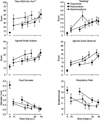The relative abuse liability of oral oxycodone, hydrocodone and hydromorphone assessed in prescription opioid abusers
- PMID: 18606504
- PMCID: PMC2668197
- DOI: 10.1016/j.drugalcdep.2008.05.007
The relative abuse liability of oral oxycodone, hydrocodone and hydromorphone assessed in prescription opioid abusers
Abstract
Abuse of prescription opioids has risen precipitously in the United States. Few controlled comparisons of the abuse liability of the most commonly abused opioids have been conducted. This outpatient study employed a double-blind, randomized, within-subject, placebo-controlled design to examine the relative abuse potential and potency of oral oxycodone (10, 20 and 40 mg), hydrocodone (15, 30 and 45 mg), hydromorphone (10, 17.5 and 25mg) and placebo. Healthy adult volunteers (n=9) with sporadic prescription opioid abuse participated in 11 experimental sessions (6.5h in duration) conducted in a hospital setting. All three opioids produced a typical mu opioid agonist profile of subjective (increased ratings of liking, good effects, high and opiate symptoms), observer-rated, and physiological effects (miosis, modest respiratory depression, exophoria and decrements in visual threshold discrimination) that were generally dose-related. Valid relative potency assays revealed that oxycodone was roughly equipotent to or slightly more potent than hydrocodone. Hydromorphone was only modestly more potent (less than two-fold) than either hydrocodone or oxycodone, which is inconsistent with prior estimates arising from analgesic studies. These data suggest that the abuse liability profile and relative potency of these three commonly used opioids do not differ substantially from one another and suggest that analgesic potencies may not accurately reflect relative differences in abuse liability of prescription opioids.
Figures



Similar articles
-
Within-subject comparison of the psychopharmacological profiles of oral hydrocodone and oxycodone combination products in non-drug-abusing volunteers.Drug Alcohol Depend. 2009 Apr 1;101(1-2):107-14. doi: 10.1016/j.drugalcdep.2008.11.013. Epub 2008 Dec 31. Drug Alcohol Depend. 2009. PMID: 19118954 Clinical Trial.
-
Intravenous oxycodone, hydrocodone, and morphine in recreational opioid users: abuse potential and relative potencies.Psychopharmacology (Berl). 2010 Oct;212(2):193-203. doi: 10.1007/s00213-010-1942-4. Epub 2010 Jul 28. Psychopharmacology (Berl). 2010. PMID: 20665209 Free PMC article. Clinical Trial.
-
Pharmacodynamic effects of oral oxymorphone: abuse liability, analgesic profile and direct physiologic effects in humans.Addict Biol. 2016 Jan;21(1):146-58. doi: 10.1111/adb.12173. Epub 2014 Jul 31. Addict Biol. 2016. PMID: 25130052 Free PMC article. Clinical Trial.
-
Likeability and abuse liability of commonly prescribed opioids.J Med Toxicol. 2012 Dec;8(4):335-40. doi: 10.1007/s13181-012-0263-x. J Med Toxicol. 2012. PMID: 22992943 Free PMC article. Review.
-
Opioids, Opioid Antagonists.2020 Nov 24. LiverTox: Clinical and Research Information on Drug-Induced Liver Injury [Internet]. Bethesda (MD): National Institute of Diabetes and Digestive and Kidney Diseases; 2012–. 2020 Nov 24. LiverTox: Clinical and Research Information on Drug-Induced Liver Injury [Internet]. Bethesda (MD): National Institute of Diabetes and Digestive and Kidney Diseases; 2012–. PMID: 31643200 Free Books & Documents. Review.
Cited by
-
Designing opioids that deter abuse.Pain Res Treat. 2012;2012:282981. doi: 10.1155/2012/282981. Epub 2012 Nov 8. Pain Res Treat. 2012. PMID: 23213510 Free PMC article.
-
Quinine as a potential tracer for medication adherence: A pharmacokinetic and pharmacodynamic assessment of quinine alone and in combination with oxycodone in humans.J Clin Pharmacol. 2015 Dec;55(12):1332-43. doi: 10.1002/jcph.557. Epub 2015 Jul 29. J Clin Pharmacol. 2015. PMID: 26032168 Free PMC article. Clinical Trial.
-
Abuse Potential Study of ALO-02 (Extended-Release Oxycodone Surrounding Sequestered Naltrexone) Compared with Immediate-Release Oxycodone Administered Orally to Nondependent Recreational Opioid Users.Pain Med. 2017 Jun 1;18(6):1077-1088. doi: 10.1093/pm/pnw178. Pain Med. 2017. PMID: 27550954 Free PMC article. Clinical Trial.
-
Behavioral flexibility and response selection are impaired after limited exposure to oxycodone.Learn Mem. 2014 Nov 17;21(12):686-95. doi: 10.1101/lm.036251.114. Print 2014 Dec. Learn Mem. 2014. PMID: 25403457 Free PMC article.
-
Opioid-related overdose and chronic use following an initial prescription of hydrocodone versus oxycodone.PLoS One. 2022 Apr 5;17(4):e0266561. doi: 10.1371/journal.pone.0266561. eCollection 2022. PLoS One. 2022. PMID: 35381052 Free PMC article.
References
-
- Abreu ME, Bigelow GE, Fleisher L, Walsh SL. Effect of intravenous injection speed on responses to cocaine and hydromorphone in humans. Psychopharmacol. 2001;154:76–84. - PubMed
-
- American Pain Society. Principles of Analgesic Use in the Treatment of Acute Pain and Cancer Pain. Fourth Edition. Glenview, IL: American Pain Society; 1999.
-
- Angst MS, Drover DR, Lotsch J, Ramaswamy B, Naidu S, Wada R, Stanski DR. Pharmacodynamics of orally administered sustained-release hydromorphone in humans. Anesthesiology. 2001;94:63–73. - PubMed
-
- Beaver WT, Wallenstein SL, Rogers A, Houde RW. Analgesic studies of codeine and oxycodone in patients with cancer; II: Comparisons of intramuscular oxycodone with intramuscular morphine and codeine. J Pharmacol Exp Ther. 1978;207:101–108. - PubMed
Publication types
MeSH terms
Substances
Grants and funding
LinkOut - more resources
Full Text Sources
Other Literature Sources
Medical
Research Materials

